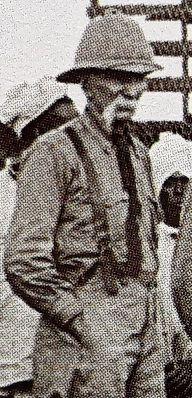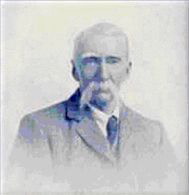Back to search results
Name: BARBER, Henry Mitford 'Hal' (later Mitford-Barberton) 'Hal' FRGS



Nee: son of Frederick William Barber of S. Africa
Birth Date: 7 Sep 1850 Grahamstown, S. Africa
Death Date: 25 May 1920 Soy, blackwater fever
First Date: 1912
Last Date: 1920
Area: Eldoret, 'Caverndale' Mount Elgon, 1922 Soy, 1912 'Ivanhoe' Kiambu
Married: In Bathurst, Cape Colony 28 Mar 1894 Mary Layard Bowker (his cousin, see her entry under Mitford-Barberton) b. 26 Apr 1863 Cape Town, d. 8 Mar 1928 Nanyuki, blackwater fever
Children: Ivan Graham (1 Feb 1896 Somerset East-1976, see entry); Raymond Berners (1 Aug 1897 Grahamstown-1985, see entry); Thane Renshaw (2 July 1901 Durban-1982, see entry); Alban McGowan (9 Dec 1904 Port Alfred-1983, see entry)
Book Reference: KFA, Red 25, Hut, Red 22, Trans Nzoia Scrap Book, Web, Nicholls, Burke, Bowkers, Red 19, Leader 14, Barnes
General Information:
KFA - Trans Nzoia - Among those who did cross [Nzoia River] was Henry Mitford-Barberton, one of the earliest coffee-planters at Kiambu. Pioneering was nothing new to him; with his brother Frederick, he had founded the town of Barberton in SA, and given his name to Barberton daisies. The brothers had been born into the well-known South African family of Barber; having had a town called after them, they changed their name to that of the town, probably a unique procedure. And so Henry Barberton and the eldest of his four sons, Ivan, arrived on Mount Elgon in a mule-cart in 1913. Later he was joined there by his wife, one of the Bowker family, an enthusiastic amateur botanist, entomologist and astronomer, who caused constant anxiety to her family by her habit of reading late into the night, or even all night, by candle-light. "Things would get on fire," one of her sons has written, "books, newspapers, and of course that botheration of necessity the mosquito net. There would be loud shrieks and the 'fire brigade' would rush to the rescue. The damage was usually slight, but sometimes it was not quite such a trifle and Mother would be rather subdued and penitent next day. ......... Mother was always game for anything, climbing hills and mountains, sleeping under the stars, she was always plucky and full of energy." ............ During WW1 he and his wife developed their land on the slopes of Mount Elgon as best they could with supplies of all essential goods cut off, African labour almost impossible to get and their camp over 100 miles from the railway.
KFA - Purchaser of Lease on the Trans Nzoia - 1913
Mount Elgon Saw Mill - In about 1910 Odin Sunde set up a saw mill on the Rongai River which flows down the North-East slope of Mount Elgon. His home-made water wheel drove the circular saw and the rawhide belt was regularly chewed up by hyenas at night. His Post Office was Soy, 45 miles away, and all timber had to be moved the 120 miles to railhead at Londiani by ox-wagons without benefit of roads or bridges. In 1922, with a loan from Henry Mitford-Barberton and in partnership with Sven Lovan and Petter Axelsson, Odin established a new mill further north near the Chepchoine River. In 1927 Edward Josselyn, late works manager of Arthur Ransome & Co., bought out Loven and Axelsson and two years later with Leigh Norman as third partner yet another mill with up-to-date equipment was built near the Kwoitobbos River. Two of Odin's sons, Odin and Arthur, were by then helping in the family business, and in 1930 Mount Elgon Saw Mills was registered in Uganda. The following year Leigh Norman left the mill and bought a farm near Endebess which he called 'Dunmillin'. When his friends enquired as to the origin of this unusual name, he would only look at them with a twinkle in his very blue eye and we have been left to speculate ever since! In 1934 Edward Josselyn became the sole owner of what was by now a limited liability company, and his son Dick came out from England to learn the trade, which was a fortunate arrangement as Edward died that same year while on a business trip to Rhodesia. Since then the Mill has been run by his wife and son, but in 1937 'Tub' Roberts joined the firm as manager and in true tradition married the boss's daughter Mary.
Web - Founded the town of Barberton, Eastern Transvaal in 1884. On the expedition to the Victoria Falls in 1875 was tossed by a buffalo. His brother nursed him for 3 months until he could be carried the 70 miles back to the wagon. Through this misfortune he was unable to go to the Falls. On another hunting expedition he was badly mauled by a leopard. He was a remarkable rifle shot and on one occasion won the Wimbledon Medal. After Barberton the brothers were important pioneers on the Rand and were associated with many of the early gold mines. Immigrated to Kenya in 1912 where he was the first settler in the Trans-Nzoia farming coffee.
Burke - co-founder of the town of Barberton 1884 and co-discoverer of the gold reefs there, farmer, rand pioneer and big game hunter, emigrated to BEA 1912, coffee planter and pioneer settler in the Trans Nzoia district, assumed the surname of Mitford-Barberton 1916.
Bowkers - Henry Mitford Barber, who later in life assumed the surname of Mitford-Barberton, was the second son of Frederick William and Mary Barber and was born at 'Highlands' on 7 September 1850. He was the true type of hardy pioneer, a natural leader, well liked by all men whether diamond-digging in Kimberley or gold-mining in Barberton and Johannesburg. The book 'Men of the Times' refers to him as 'Foremost among the great pioneers of the Rand and a prominent personality in the historical annals of South Africa.' A keen hunter, he penetrated into the wilds of the Transvaal, Matabeleland, Portuguese East Africa, and the Kalahari Desert. He was a Fellow of the Royal Geographical Society and an ardent naturalist, and discovered several new species of insects and butterflies. An exceptionally fine rifle shot, he won many shooting medals and prizes, including the much coveted 'Wimbledon Medal' which was competed for by all the keenest marksmen in Johannesburg. On his hunting expeditions he shot 7 lions and much other big game of almost all species and at one time held some of the world records in antelope horns. His almost too fearless nature led to many exciting adventures and on several occasions he shot a charging lion so that it dropped dead within a few feet of his rifle. In Matabeleland he was badly gored by a buffalo, and some years later severely mauled by a leopard on the Sabi River. As a young man he dug diamonds in Kimberley with the rest of the family. One alarming experience was when he was ascending from their claim and the rope broke so that he fell back 30 feet on to a 4-foot wide ledge. He was also in Kimberley when all the powder magazines exploded, breaking every window in the town. ………… [lots, lots more on his hunting exploits] ………. In 1884 Fred and Hal Barber were prospecting in the 'de Kaap' Valley when they discovered what we believe was the first gold reef in the Transvaal. The news of the discovery brought a great influx of prospectors and soon some thousands were camped in the valley at what was then known as Barbers' Camp. After about a dozen canteens had been put up, the place began to look like a town so the Government sent a Commissioner to establish control. A diggers' committee was elected and the town was named Barberton. The reef which the Barber brothers were working pinched out so they returned to farm in the Cape Colony, but the ruins of their stone house and the old mine are still to be seen on the hill above Rimer's Creek at Barberton. The discovery of gold on the Rand in 1886 completely eclipsed Barberton. All the diggers, prospectors, crooks and anyone else who wanted to get rich quickly, whether at his own or anyone else's expense, trekked off to the Rand, bent on making his fortune in the least possible time. The Barber brothers purchased some claims from Col. Ferreira and they sank the very first shaft on the Witwatersrand, carrying it down to a depth of 50 feet, thus proving the permanency of the reef. They also floated , or were instrumental in floating, some of the first gold-mining companies on the Rand, including the Simmer & Jack. Their fortunes varied like the Stock Exchange, and at one time they were worth £85,000 between them, but in 1894, when Hal married, the partnership dissolved with about £20,000 each. After farming in different parts of South Africa, Hal emigrated to Kenya Colony in 1912 and became a coffee planter at Kyambu near Nairobi. It was here that he assumed the surname of Mitford-Barberton. His brother Fred followed him in 1915 and bought land at Mount Elgon where his brother was then farming. Fred and Hal both died in Kenya and they are buried at Eldoret. Their descendants, with the exception of Ivan, are still living in Kenya Colony.
Red Book 1919 - H M Barberton - Settler - Kyambu
Gazette - 11/8/1920 - Probate and Administration - Henry Mitford Barberton late of Uasin Gishu who died at Uasin Gishu on 25th May 1920. Applied for by Ivan Graham Mitford Barberton
Gazette - 7/4/15 - Liable for Jury service, Kiambu - H.M. Barber, Ivanhee [sic], Kiambu
Gazette - 29/10/1919 - Register of Voters - Plateau North - Homy [sic] M. Barberton - Farmer, Soy
Eldoret cemetery to the glory / of God and / in loving / memory of / Frederick Hugh Barber / born 8.1.1847 died 17 .5.1919 Henry Mitford Barberton / born 7.9.1850 died 25.5.1920 / sons of F W Barber of S.A.
Back to search results



